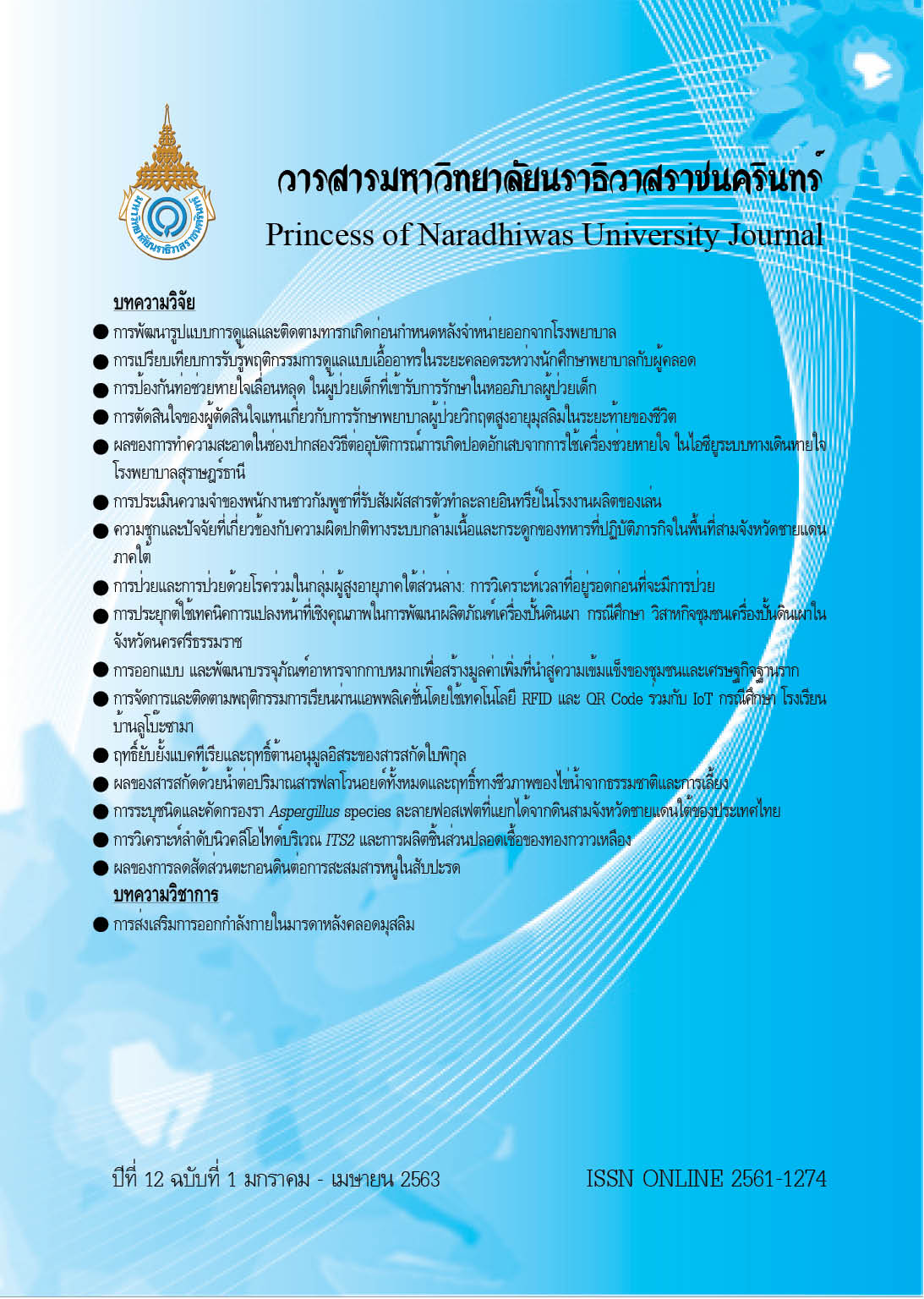Identification and Screening of Phosphate Solubilizing Aspergillus Species Isolated from Soil in the Three Southern Border Provinces of Thailand
Keywords:
Aspergillus spp, Identification, PhosphateAbstract
Fungi of the genus Aspergillus have great importance in ecological systems. This research was conducted to identify Aspergillus spp. isolated from soil in Narathiwat, Pattani, and Yala provinces and screen phosphate solubilizing strains. Forty-three species of Aspergillus spp. were isolated from soil by tenfold serial dilution method, and potato dextrose agar (PDA) pour plate metthod. All isolates were identified, based on morphological characters and nucleotide sequence of the internal transcribed spacers (ITS) and distributed into 7 species, namely: A. aculeatus, A. alabamensis, A. carbonarius, A. clavatus, A. japonicus, A. niger and A. terreus. Phosphate solubilizing ability of Aspergillus spp., isolated from soil, was screened by halo zone test on Pikovskaya’s agar medium. The result revealed that A. alabamensis and A. carbonarius were able to solubilize phosphate in vitro.
References
Arulselvi, T., Kanimozhi, G. & Panneerselvam, A. (2018). Isolation and characterization of phosphate solubilizing fungi from the soil sample of Muthupet mangroves. International Journal of Scientific Research in Science and Technology, 4(9), 30 – 37.
Hefnawy, A.M., Gharieb, M.M., Eissa, A.O. & Ammar, M.A. (2009). Evolution and optimization of rock phosphate and tricalcium phosphate solublization by some soil fungi. The Egyptian Society of Experimental Biology, 5, 75 – 84.
Kumar, S., Stecher, G. & Tamura, K. (2016). MEGA7: Molecular Evolutionary Genetics Analysis version 7.0 for bigger datasets. Molecular Biology and Evolution, 33(7), 1870 – 1874.
Klich, M.A. (2002). Biogeography of Aspergillus species in soil and litter. Mycologia, 94(1), 21 – 27.
Mehta, P., Sharma, R., Putatunda, C., Walia, A. (2019). Endophytic fungi: role in phosphate solubilization. In Singh, B. (editor), Advances in Endophytic Fungal Research. (pp.183 – 209). Fungal Biology: Springer, Cham.
Petrovic, J.J., Jeremic, S., Vuckovic, I., Vojnovic, S., Bulajic, A., Raicevic, V. et al., (2016). Aspergillus piperis A/5 from plum-distilling waste compost produces a complex of antifungal metabolites active against the phytopathogen. Pythium aphanidermatum Archives of Biological Sciences, 68(2), 279–289.
Premono, M.E., Moawad, A.M. & Vlek, P.L.G. (1996). Effect of phosphate-solubilizing Pseudomonas putida on the growth of maize and its survival in the rhizosphere. Indonesian Journal of Crop Science,11(1), 13 - 23.
Saitoh, K.I., Togashi, K. & Arie, T. (2006). A simple method for a mini-preparation of fungal DNA. Journal of General Plant Pathology, 72(6), 348 – 350.
Samson, R.A., Noonim, P., Meijer, M., Houbraken, J., Frisvad, J.C. & Varga, J. (2007). Diagnostic tools to identify black Aspergilli. Studies in Mycology, 59, 129-145.
Suarez, E.F., Vargas, G.C., Lopez M.J., Capel, C. & Moreno, J. (2007). Antagonistic activity of bacteria and fungi from horticultural compost against Fusarium oxysporum f sp. melonis. Crop Protection, 26(1), 46-53.
Tamura, K., Peterson, D., Peterson, N., Stecher, G., Nei, M. & Kumar, S. (2011). MEGA5: Molecular Evolutionary Genetics Analysis Using Maximum Likelihood, Evolutionary Distance, and Maximum Parsimony Methods. Molecular Biology and Evolution, 28(10), 2731–2739
Thompson, J.D., Higgins, D.G. & Gibson, T.J. (1994) CLUSTAL W: improving the sensitivity of progressive multiple sequence alignment through sequence weighting, position-specific gap penalties and weight matrix choice. Nucleic Acids Research, 22(22), 4673-4680.
Varga, J., Frisvad, J.C., Kocsubé, S., Brankovics, B., Tóth, B., Szigeti, G. et al., (2011). New and revisited species in Aspergillus section Nigri. Studies in Mycology, 69(1), 1–17.
White, J.T., Bruns, D.T., Lee, B.S. & Taylor, J.W. (1990). Amplification and Direct Sequencing of Fungal Ribosomal RNA Genes for Phylogenetics. In Innis, M.A., Gelfand, D.H., Sninsky, J.J. and White, T.J. (editor), PCR Protocols: A Guide to Methods and Applications. (pp.315-322). New York: Academic Press.




